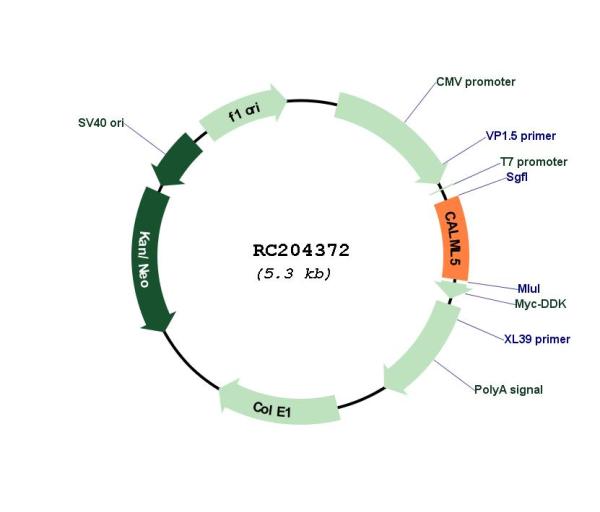CALML5 (NM_017422) Human Tagged ORF Clone
CAT#: RC204372
CALML5 (Myc-DDK-tagged)-Human calmodulin-like 5 (CALML5)
ORF Plasmid: tGFP
Lentiviral Particles: DDK w/ Puro mGFP w/ Puro
AAV Particle: DDK
"NM_017422" in other vectors (4)
USD 198.00
Specifications
| Product Data | |
| Type | Human Tagged ORF Clone |
| Tag | Myc-DDK |
| Symbol | CALML5 |
| Synonyms | CLSP |
| Vector | pCMV6-Entry |
| E. coli Selection | Kanamycin (25 ug/mL) |
| Mammalian Cell Selection | Neomycin |
| Sequence Data |
>RC204372 ORF sequence
Red=Cloning site Blue=ORF Green=Tags(s) TTTTGTAATACGACTCACTATAGGGCGGCCGGGAATTCGTCGACTGGATCCGGTACCGAGGAGATCTGCC GCCGCGATCGCC ATGGCCGGTGAGCTGACTCCTGAGGAGGAGGCCCAGTACAAAAAGGCTTTCTCCGCGGTTGACACGGATG GAAACGGCACCATCAATGCCCAGGAGCTGGGCGCGGCGCTGAAGGCCACGGGCAAGAACCTCTCGGAGGC CCAGCTAAGGAAACTCATCTCCGAGGTTGACGGCGACGGCGACGGCGAAATCAGCTTCCAGGAGTTCCTG ACGGCGGCAAGGAAGGCCAGGGCCGGCCTGGAGGACCTGCAGGTCGCCTTCCGCGCCTTCGACCAGGATG GCGACGGCCACATCACCGTGGACGAGCTCAGGCGGGCCATGGCGGGGCTGGGGCAGCCGCTGCCGCAGGA GGAGCTGGACGCCATGATCCGCGAGGCCGACGTGGACCAGGACGGGCGGGTGAACTACGAGGAGTTCGCG AGGATGCTCGCCCAGGAG ACGCGTACGCGGCCGCTCGAGCAGAAACTCATCTCAGAAGAGGATCTGGCAGCAAATGATATCCTGGATT ACAAGGATGACGACGATAAGGTTTAA >RC204372 protein sequence
Red=Cloning site Green=Tags(s) MAGELTPEEEAQYKKAFSAVDTDGNGTINAQELGAALKATGKNLSEAQLRKLISEVDGDGDGEISFQEFL TAARKARAGLEDLQVAFRAFDQDGDGHITVDELRRAMAGLGQPLPQEELDAMIREADVDQDGRVNYEEFA RMLAQE TRTRPLEQKLISEEDLAANDILDYKDDDDKV |
| Chromatograms |
CHROMATOGRAMS
 Sequencher program is needed, download here. |
| Restriction Sites |
SgfI-MluI
Cloning Scheme for this gene
Plasmid Map

|
| ACCN | NM_017422 |
| ORF Size | 438 bp |
| OTI Disclaimer | The molecular sequence of this clone aligns with the gene accession number as a point of reference only. However, individual transcript sequences of the same gene can differ through naturally occurring variations (e.g. polymorphisms), each with its own valid existence. This clone is substantially in agreement with the reference, but a complete review of all prevailing variants is recommended prior to use. More info |
| OTI Annotation | This clone was engineered to express the complete ORF with an expression tag. Expression varies depending on the nature of the gene. |
| Product Components | The ORF clone is ion-exchange column purified and shipped in a 2D barcoded Matrix tube containing 10ug of transfection-ready, dried plasmid DNA (reconstitute with 100 ul of water). |
| Reconstitution | 1. Centrifuge at 5,000xg for 5min. 2. Carefully open the tube and add 100ul of sterile water to dissolve the DNA. 3. Close the tube and incubate for 10 minutes at room temperature. 4. Briefly vortex the tube and then do a quick spin (less than 5000xg) to concentrate the liquid at the bottom. 5. Store the suspended plasmid at -20°C. The DNA is stable for at least one year from date of shipping when stored at -20°C. |
| Reference Data | |
| RefSeq | NM_017422.5 |
| RefSeq Size | 893 bp |
| RefSeq ORF | 441 bp |
| Locus ID | 51806 |
| UniProt ID | Q9NZT1 |
| Cytogenetics | 10p15.1 |
| Protein Pathways | Alzheimer's disease, Calcium signaling pathway, Glioma, GnRH signaling pathway, Insulin signaling pathway, Long-term potentiation, Melanogenesis, Neurotrophin signaling pathway, Olfactory transduction, Oocyte meiosis, Phosphatidylinositol signaling system, Vascular smooth muscle contraction |
| MW | 15.9 kDa |
| Gene Summary | This gene encodes a novel calcium binding protein expressed in the epidermis and related to the calmodulin family of calcium binding proteins. Functional studies with recombinant protein demonstrate it does bind calcium and undergoes a conformational change when it does so. Abundant expression is detected only in reconstructed epidermis and is restricted to differentiating keratinocytes. In addition, it can associate with transglutaminase 3, shown to be a key enzyme in the terminal differentiation of keratinocytes. [provided by RefSeq, Jul 2008] |
Documents
| Product Manuals |
| FAQs |
| SDS |
Resources
Other Versions
| SKU | Description | Size | Price |
|---|---|---|---|
| RC204372L3 | Lenti ORF clone of Human calmodulin-like 5 (CALML5), Myc-DDK-tagged |
USD 450.00 |
|
| RC204372L4 | Lenti ORF clone of Human calmodulin-like 5 (CALML5), mGFP tagged |
USD 450.00 |
|
| RG204372 | CALML5 (tGFP-tagged) - Human calmodulin-like 5 (CALML5) |
USD 350.00 |
|
| SC122857 | CALML5 (untagged)-Human calmodulin-like 5 (CALML5) |
USD 150.00 |
{0} Product Review(s)
Be the first one to submit a review






























































































































































































































































 Germany
Germany
 Japan
Japan
 United Kingdom
United Kingdom
 China
China





